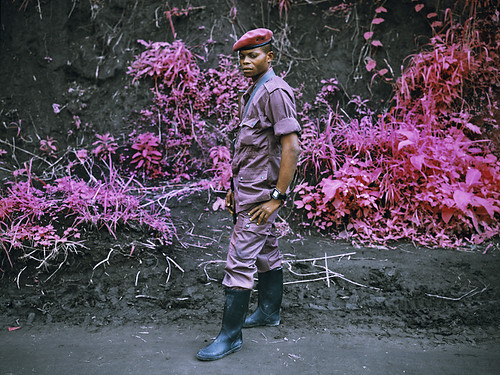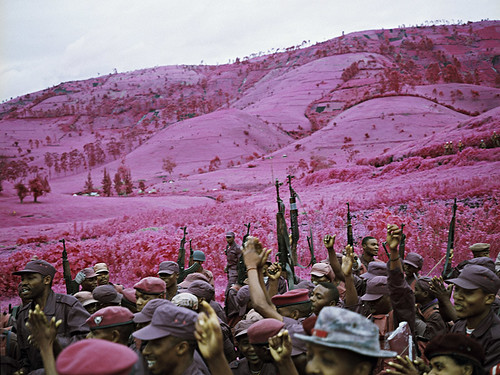10.21.2011
10.20.2011
tenhi - viimeiseen
Through Bloom-blades
In a grave grove
Lay on the bones
Feel deep with the leaves
Linger in meadows and spring-plains
Through bloom-blades the dead utter
Hear the bones collide
Feel when night runs through into deeper shadows
Only flowers this july
Wait here in summer's breath
10.19.2011
melancology
Black metal irrupts from a place already divested of nature, a site of extinction, ‘a place empty of life / Only dead trees …’ (Mayhem, ‘Funeral Fog’, 1992); ‘Our skies are forever black / Here is no signs of life at all’ (Deathspell Omega, ‘From Unknown Lands of Desolation’, 2005). As such black metal could be described as a negative form of environmental writing; the least Apollonian of genres, it is terrestrial – indeed subterranean and infernal – inhabiting a dead forest that is at once both mythic and real unfolding along an atheological horizon that marks the limit of absolute evil where there are no goods or resources to distribute and therefore no means of power and domination, a mastery of nothing.
A new word is required that conjoins ‘black’ and ‘ecology’: melancology, a word in which can be heard the melancholy affect appropriate to the conjunction. A new word implies a new concept and we know from Deleuze and Guattari that concepts have to fulfil three criteria. Accordingly, the plane of immanence of melancology is extinction and non-being. All things are destined for extinction; immanent to all being is the irreducible fact of its total negation without reserve or remainder. The development of the characteristics of melancology is to be addressed at the Symposium, of course, but there are already a number of apophasic determinations: it is not ecology, it is anorganic; it is not political economy, it is anti-instrumental; it is not love of nature, environmentalism, Gaia, geophilosophy … But it implies an ethos and a style that delineates the third aspect of the concept, its embodiment in a conceptual personae: the black metal kvltist whose ethos runs across the spectrum of melancholy from bile and rage to sorrow, depression and the delectation of evil all the better to affirm the desolation s/he contemplates in the sonorous audibility of black metal’s sovereign dissonance.
-BlackMetalThreorySymposium, Nov 2010
A new word is required that conjoins ‘black’ and ‘ecology’: melancology, a word in which can be heard the melancholy affect appropriate to the conjunction. A new word implies a new concept and we know from Deleuze and Guattari that concepts have to fulfil three criteria. Accordingly, the plane of immanence of melancology is extinction and non-being. All things are destined for extinction; immanent to all being is the irreducible fact of its total negation without reserve or remainder. The development of the characteristics of melancology is to be addressed at the Symposium, of course, but there are already a number of apophasic determinations: it is not ecology, it is anorganic; it is not political economy, it is anti-instrumental; it is not love of nature, environmentalism, Gaia, geophilosophy … But it implies an ethos and a style that delineates the third aspect of the concept, its embodiment in a conceptual personae: the black metal kvltist whose ethos runs across the spectrum of melancholy from bile and rage to sorrow, depression and the delectation of evil all the better to affirm the desolation s/he contemplates in the sonorous audibility of black metal’s sovereign dissonance.
-BlackMetalThreorySymposium, Nov 2010
10.18.2011
marginalia
marginalia and other crimes. cambridge university library.
case 2 - borrowable stock, damage outside the library
some damage is accidental. books get damaged in house-fires, in floods when water-pipes burst and other unforeseen accidents. readers pay for replacement copies. and these expense may be covered by their household insurance policies.
water, fire, miscellaneous, ink, coffee, not OK for bath, not OK for bath, OK for bath, rain,bottle of water
case 3 - damage by animals, small humans and birds
other damage that might be grouped under the heading of carelessness includes: books chewed by dogs, children's artistic additions to the text, books chewed by mice.
dog, dog, mice, mice, mice, child's sticker, child's sticker, child's scribbling, child's scribbling, pigeon droppings?, safe keeping - a plastic bag
case 4 - marginalia
these examples of marginal notes are typical of much of the damage done to our stock. although pencil marks can be erased, however carefully the marks are removed, it does damage the text. and if a text is marked and erased a few times it is ruined.
ink, signed, signed, comments on comments, comments on comments, single author many books, single author many books, ?, international
case 5 - colored marginalia
marked text comes in many colors. the use of color-changing pencils, in these two examples, helped identify the culprit.
pencil crayon, pencil crayon, highlighter one color, highlighter multiple colors, highlighter multiple colors, underlines in ink, marginal comments as well, highlighter multiple colors, highlighter multiple colors, underlines in ink, marginal comments as well
case 6 - pencil marking and adhesive notes
pencil marking, whole page, whole page, small amounts in ink - still pay for whole book, adhesive notes, adhesive notes, adhesive notes, adhesive notes
case 7 - physical damage
how the UL responds to the damage
accidents: books damaged by accident are replaced with the same edition. the reader is charged the replacement price plus an administration charge. the damaged copy is stored at 'class z'. some readers ask to have the damaged copy but it is not permitted. the new copy is put at the same location, with the same classmark, that the damaged copy originally had.
defacement: books damaged deliberately are replaced with the same edition. the reader is charged the replacement price plus an administration charge. the library syndicate levies a fine of up to £175, depending on the circumstances. on the first offense, once all fines are paid, the reader usually retains their privilege of using UL. we have not had a case of a second offense. these matters are usually settled in-house. but replacement costs quickly accumulate into large sums. one case cost the reader £2,500 in total.
abstraction: ripping pages from texts is regarded as theft. the police may be involved and readers who are successfully prosecuted lose all their privileges to use UL forever. texts are replaced and stored at higher levels of security. the original copy is retained at class z.
tearing out pages, tearing out pages, tearing out pages, cutting out photo
10.09.2011
7.25.2011
melancholia
we have a big heart for melancholia - sadness is beautiful. the blue side of life is where we are as persons and as artists. the music also reflects our introversion.
- tenhi.
3.15.2011
richard mosse


British Journal of Photography
March 25 2010
Richard Mosse: La Vie En Rose
by Olivier Laurent
Ask Richard Mosse what first fascinated him about the Congo and he'll give you a long list. "Joseph Conrad. Tin Tin. The Rumble in the Jungle. The Belgian colonial legacy. The beer. The Ebola virus. A country the size of Western Europe with less paved roads than Ireland. The ‘bulletproof' Mai Mai warriors. A conflict so pathologised that it is well past the point of human comprehension."
But it's the latter reason that led the Irish-born photographer to use Kodak's Aerochrome film. Discontinued last year, the film is particularly sensitive to infra-red light, rather than to the usual visible spectrum of colours registered by traditional film. Since foliage reflects infra-red while buildings don't, the US Army used it during the Vietnam War to detect and reveal hidden soldiers. "I wanted to export this technology to a harder situation, to up-end the generic conventions of calcified mass-media narratives and challenge the way we're allowed to represent this forgotten conflict," says Mosse. "I wanted to confront this military reconnaissance technology, to use it reflexively in order to question the ways in which war photography is constructed."
Mosse was first inspired to use the film after seeing the work of Florian Maier-Aichen. "This German artist rejects the influence of the Kunstakademie Düsseldorf and the Becher school to embrace a kind of Romantic exploration of the landscape of the American West," says Mosse. "I was moved by the beauty of this work, and wondered whether he used colour infra-red film to compose certain images. I'm not sure whether he actually did, but I got excited by the technology, which is considered to be a kind of photographic taboo – thou shalt not cross-process; thou shalt not use colour infra-red film."
While Mosse refuses to reveal where he got the discontinued film - "I could tell you but then I'd have to kill you," he jokes – up until February, a small company in Germany supplied it in the 120 medium format by cutting it down from a large roll stock. However, even that supplier has now run out of the film, BJP understands. But this setback hasn't deterred Mosse from his continued interest in Congo and infra-red technology. The 30-year-old photographer plans to go back next year with cinematographer Trevor Tweeten, with whom he's worked on previous projects.
"We plan to shoot IR Red One video. That involves sending the Red One camera back to the factory where the OLPF filter will be removed from the digital sensor." The result "will be quite extraordinary and very different to the old Aerochrome stock," he says. "It will be a kind of blown-out monochrome palette. We've actually shot infra-red before in Iraq, where Trevor repurposed his Zeiss lens to peer through a US Army IR goggle eyepiece. The result was this nightmarish green-and-black palette, rather like the old DOS interface for anyone old enough to remember computer screens before Windows and the Mac Classic."
However, he says, "the IR we will shoot in Congo will probably look a lot different, rather like the moment an atom bomb detonates. The world will seem shadowless, like a breathless high-noon desert landscape, yet we'll be beating through the jungle shadows."
www.richardmosse.com
kris kuksi
“A post-industrial Rococo master, Kris Kuksi obsessively arranges characters and architecture in asymmetric compositions with an exquisite sense of drama. Instead of stones and shells he uses screaming plastic soldiers, miniature engine blocks, towering spires and assorted debris to form his landscapes.The political, spiritual and material conflict within these shrines is enacted under the calm gaze of remote deities and august statuary. Kuksi manages to evoke, at once, a sanctum and a mausoleum for our suffocated spirit.”
Guillermo del Toro
for the past couple of years, i've been fascinated by kuksi's sculptures - thanks to D who first introduced me to this amazing body of spiritual intensity.
1) obsessively delicate sculpting, 2) militant, dogmatic messages to the contrary, 3) multiple microcosmic narratives within each piece, 4) solitary craftsmanship, 5) tension between smallness of human and aspiration to surpass it - a.k.a. religious.
Subscribe to:
Posts (Atom)




